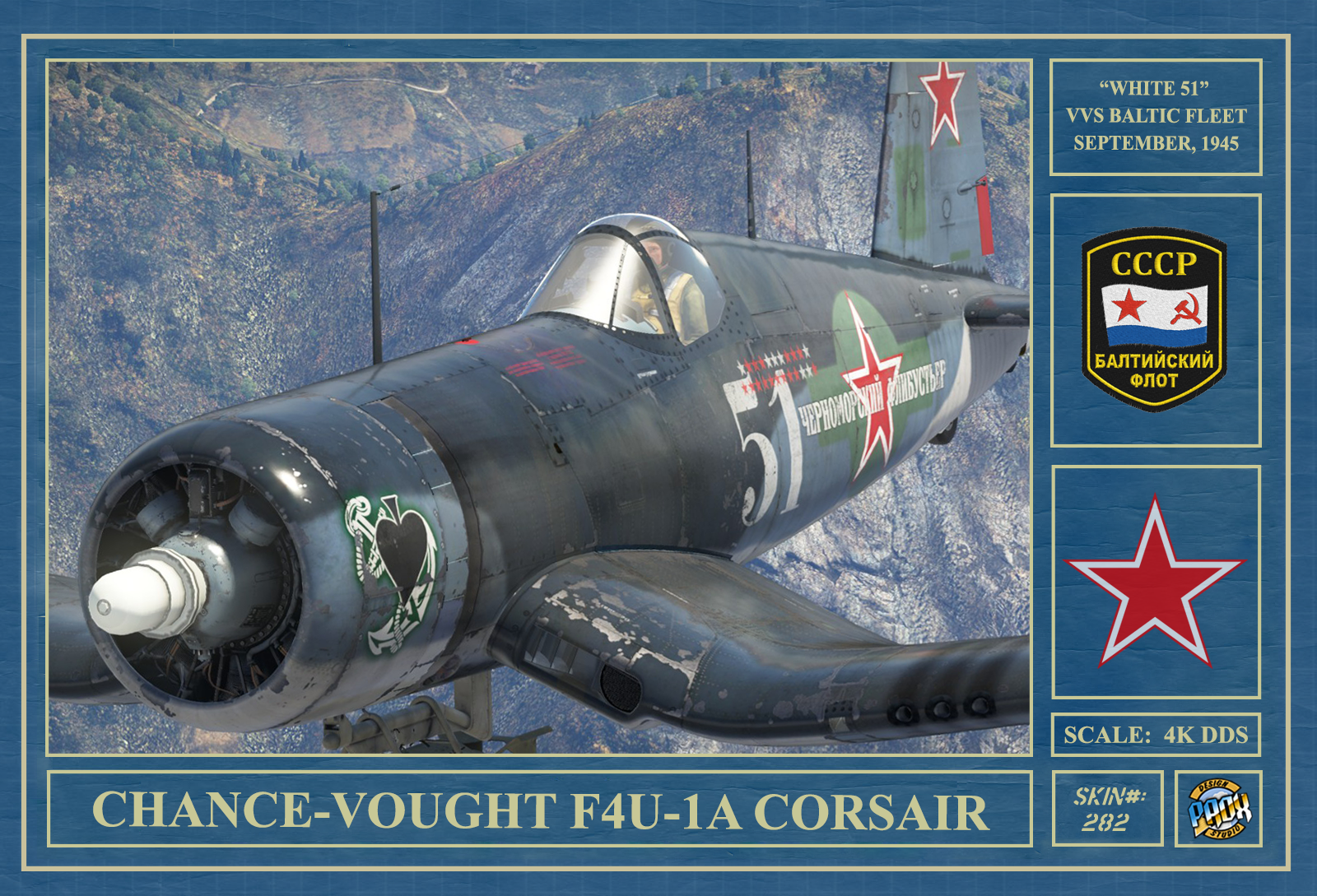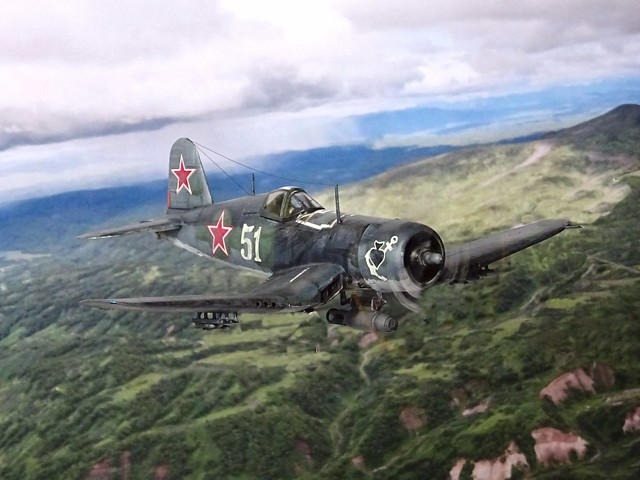LOL
Navigation
Install the app
How to install the app on iOS
Follow along with the video below to see how to install our site as a web app on your home screen.
Note: This feature may not be available in some browsers.
More options
You are using an out of date browser. It may not display this or other websites correctly.
You should upgrade or use an alternative browser.
You should upgrade or use an alternative browser.
USA Lend-Lease f4U Corsair to Russia?
- Thread starter Yaldy
- Start date
Ad: This forum contains affiliate links to products on Amazon and eBay. More information in Terms and rules
More options
Who Replied?I'm pretty sure that all the P-47s went to Russian Naval Aviation-Fleet defense in the Black sea Fleet . The B-25s were modified ( Turret Location) in Rodina. What about the 3 B-29s that were interred ? Anyone know whether the PR Mk IV spits that they got were based on the Mk I or the Mk V?
Jabberwocky
Tech Sergeant
Does anyone know anything about the US giving Russia any F4U Corsairs during World War 2?
The reason I ask - A person claimed to have met a Hero of the Soviet Union who flew a Corsair with 55 kills.
I was skeptical and said, "I"m not sure about this..."
Any help, knowledge, or comments are appreciated.
Thanks in advance!
Top Soviet WW2 aces (Credited kills):
Ivan Nikitovich Kozhedub (64 inc 2 P-51's)
Alexandre Ivanovich Pokryshkin (59)
Nikolai Dimitrievich Gulayev (57)
Grigori Andreevich Rechkalov (56)
Kirill Alexeevich Yevstigneyev (53)
Arsenii Vasilyevich Vorozheykin (52)
Dmitri Borisovich Glinka (50)
So, your unnamed ace would slot in between Gulayeva and Rechkalov.
renrich
Chief Master Sergeant
My reference which lists all the Corsairs built and to whom they were delivered shows none to the Soviet Union.
Glider
Major
Re the three B29's that the Russians aquired.
The first was B-29-5-BW Serial No 42-6256 the 52nd off the production line. Was hit by AA guns over Anshan that knocked out No 3 engine and damaged no 4 and landed on the 29th July at Tavrichanka. The captain was Capt Jarrell.
The second was B-29-15-BW Serial No 42-6365 the 'General H H Arnold Special' captained by Capt Price. After bombing Omura had ran low on fuel due to not receiving a recall message due to strong headwinds that hadn't been forcast. He landed at Vladivostok on 11th November
The third was also a B-29-15-BW Serial No 42-6358 the 'Ding How' captained by Lt Mickish. This was hit over Omura by fighters and he also landed at Vladivostok on 21st November.
As an aside this mission involved 109 bombers, one crashed on take off and another eight failed to make it home mostly due to damage from fighters who reacted strongly according to reports. By no means did the USA have it all their own way in these early missions.
The Russians had always planned to 'aquire' B29's as soon as they were deployed in theatre. The Russian airbases were offerred as a safe landing ground to the USA as allies, but the Russians always planned to keep any planes that landed. The excuse to be used and was used, was that Russia wasn't at war with Japan and as a neutral had to impound millitary equipment that could be used against another country.
You have to admit they would have made great lawyers.
Hope this is of interest
The first was B-29-5-BW Serial No 42-6256 the 52nd off the production line. Was hit by AA guns over Anshan that knocked out No 3 engine and damaged no 4 and landed on the 29th July at Tavrichanka. The captain was Capt Jarrell.
The second was B-29-15-BW Serial No 42-6365 the 'General H H Arnold Special' captained by Capt Price. After bombing Omura had ran low on fuel due to not receiving a recall message due to strong headwinds that hadn't been forcast. He landed at Vladivostok on 11th November
The third was also a B-29-15-BW Serial No 42-6358 the 'Ding How' captained by Lt Mickish. This was hit over Omura by fighters and he also landed at Vladivostok on 21st November.
As an aside this mission involved 109 bombers, one crashed on take off and another eight failed to make it home mostly due to damage from fighters who reacted strongly according to reports. By no means did the USA have it all their own way in these early missions.
The Russians had always planned to 'aquire' B29's as soon as they were deployed in theatre. The Russian airbases were offerred as a safe landing ground to the USA as allies, but the Russians always planned to keep any planes that landed. The excuse to be used and was used, was that Russia wasn't at war with Japan and as a neutral had to impound millitary equipment that could be used against another country.
You have to admit they would have made great lawyers.
Hope this is of interest
"Never" is a risky word, but I'll risk it for Soviet Lend Lease Corsairs: there weren't any.
Corsairs captured in Korea would be a close second, highly unlikely. The Soviets did restore at least one crashed F-86 to flying condition, but never heard of any Corsairs and hard to see why by that point they would have bothered restoring crashed Corsairs. None were for example left behind nicely intact on overrun airfields.
A remotely possible twist on the story might be Soviet aces from WWII who *claimed* Corsairs in Korea. One self described low scoring Soviet ace from WWII did that (the loss is not reflected in US records though, nor is he listed as WWII ace in references I have). A middling Soviet WWII ace Nikolai Stroikov (14 individial+21 shared), participated in the first combat between the MiG's and the USN, where there were Corsairs present but he didn't claim one AFAIK. Actually Soviet MiG's didn't down any Corsairs, the three lost in air combat were to non-Soviet MiG's. Relax the story another degree to claimed other US prop types and there's a few more....
Joe
Corsairs captured in Korea would be a close second, highly unlikely. The Soviets did restore at least one crashed F-86 to flying condition, but never heard of any Corsairs and hard to see why by that point they would have bothered restoring crashed Corsairs. None were for example left behind nicely intact on overrun airfields.
A remotely possible twist on the story might be Soviet aces from WWII who *claimed* Corsairs in Korea. One self described low scoring Soviet ace from WWII did that (the loss is not reflected in US records though, nor is he listed as WWII ace in references I have). A middling Soviet WWII ace Nikolai Stroikov (14 individial+21 shared), participated in the first combat between the MiG's and the USN, where there were Corsairs present but he didn't claim one AFAIK. Actually Soviet MiG's didn't down any Corsairs, the three lost in air combat were to non-Soviet MiG's. Relax the story another degree to claimed other US prop types and there's a few more....
Joe
HealzDevo
Staff Sergeant
Okay, would be interesting to find out the truth. They might have been sent before the USN worked out how to land them properly on carriers to get rid of some of the mistakes... It wasn't until 1944 that they became standard carrier aircraft. Therefore it is possible that prior to this some could have been given to Russia...
R Leonard
Staff Sergeant
No, doesn't matter when carrier use started. There were no F4Us provided to the USSR though lend lease, period, none. If you take the time to look things up rather than guess at "would have's" and "could have's" you can find the information, even on the internet. Idle speculation is great, but in the face of the facts it is an exercise in futility. You can check USN sources, you can check RN sources, you can check Chance-Vought sources, you can even check the lend lease list . . . and, yes, there is such a list. No F4Us to the USSR.
Rich
Rich
Un fait peu connu est que, en vertu de la loi de prêt-bail, un petit nombre d'avions de combat F4U-1A/D "Corsair" a également été livré à l'Union soviétique. La politique de prêt-bail, intitulée « Acte visant à promouvoir la défense des États-Unis », était un programme en vertu des États-Unis fournissaient la France libre, le Royaume-Uni, la République de Chine, et plus tard l'Union soviétique et d'autres pays alliés. nations avec la nourriture, du pétrole et du matériel entre 1941 et août 1945. Cela entre les navires de guerre et des avions de guerre, ainsi que d'autres armes. En général, l'aide était gratuite, bien que certains matériels (comme les navires) étaient rendus après la guerre. En retour, les États-Unis ont obtenu des baux sur des bases militaires et navales en territoire allié pendant la guerre. Le Canada a utilisé un programme similaire plus petit sous un nom différent. Seuls les marquages nationaux et les codes tactiques ont été rapidement recouverts de la peinture à portée de main, et des marquages Red Star importants ont été appliqués dans des positions standard. Plus tard, lors des révisions d'entretien de routine, certaines machines ont reçu des schémas de peinture individuels. Plusieurs machines pour le rôle d'attaque au sol ont également été équipées de manilles soviétiques et de rails de lancement pour les missiles non guidés indigènes comme le RS-82 ou le RS-132.Quelqu'un sait-il que les États-Unis ont donné à la Russie des corsaires F4U pendant la Seconde Guerre mondiale ?
La raison pour laquelle je demande - Une personne a prétendu avoir rencontré un héros de l'Union soviétique qui a piloté un Corsair avec 55 victoires.
J'étais sceptique et j'ai dit : "Je ne suis pas sûr de ça..."
Toute aide, connaissance ou commentaires sont appréciés.
Merci d'avance!
Une opération notable à laquelle les F4U soviétiques ont pris part à la libération du sud de Sakhaline en août-septembre 1945. Pendant la guerre contre le Japon, la flotte de l'océan Pacifique a débarqué avec succès un certain nombre de corps de débarquement opérationnelles et tactiques, principalement en coopération étroite avec l'armée soviétique. Unités de l'armée. Après avoir répudié le pacte de neutralité soviéto-japonais, l'Union soviétique a envahi le sud de Sakhaline, l'attaque soviétique a commencé le 11 août 1945, quelques jours avant la capitulation du Japon. Le 56e corps de fusiliers soviétique, qui fait partie de la 16e armée, composé de la 79e division de fusiliers, de la 2e brigade de fusiliers, de la 5e brigade de fusiliers et de la 214e brigade blindée, a attaqué la 88e division d' infanterie japonaise.
Bien que l'Armée rouge soviétique soit trois fois plus nombreuse que les Japonais, elle n'avança que lentement en raison de la forte résistance japonaise. Ce n'est que lorsque la 113e brigade de fusiliers et le 365e bataillon de fusiliers d'infanterie navale indépendante de Sovetskaya Gavan ont débarqué à Tōro, un village côtier de l'ouest de Karafuto, le 16 août, que les Soviétiques ont brisé la ligne de défense japonaise. La résistance japonaise s'est affaiblie après cet atterrissage. Les combats réels se sont poursuivis jusqu'au 21 août. Du 22 au 23 août, la plupart des unités japonaises restantes ont accepté un cessez-le-feu. Les Soviétiques achevèrent la conquête de Karafuto le 25 août 1945 en occupant la capitale de Toyohara.
D'autres opérations avec la participation soviétique F4U étaient la libération des îles Kouriles et de plusieurs ports le long de la côte orientale de la Corée, aboutissant finalement à Port-Artur (Lüshunkou) sur la côte de la mer Jaune. Le rond-point 150 F4U-1A/D était exploité par l'armée de l'air de la flotte soviétique du Pacifique, et après la fin des hostilités, presque tous les avions utilisés par la guerre ont été mis au point.
FLYBOYJ
"THE GREAT GAZOO"
Although this thread is 14 years old, many of the original posters are still here. With that said, great gamer story! I also heard that South Korea was given surplus observation balloons left over from the US Civil War. North Korean PO-2s would overfly these balloons and try to drop frozen Kimchi bombs on them.A little-known fact is that, under the loan-lease law, a small number of F4U-1A / D "Corsair" fighter jets were also delivered to the Soviet Union. The loan-lease policy, titled "An Act to Promote the Defense of the United States," was a program under the United States provided Free France, the United Kingdom, the Republic of China, and later the Soviet Union and other allied countries. nations with food, oil and equipment between 1941 and August 1945. This between warships and warplanes, as well as other weapons. In general, aid was free, although some materials (such as ships) were returned after the war. In return, the United States obtained leases on military and naval bases in Allied territory during the war. Canada used a similar, smaller program under a different name. Only national markings and tactical codes were quickly covered with the paint on hand, and significant Red Star markings were applied in standard positions. Later, during routine maintenance overhauls, some machines were given individual paint schemes. Several machines for the ground attack role were also fitted with Soviet shackles and launch rails for native unguided missiles like the RS-82 or RS-132. and prominent Red Star markings have been applied in standard positions. Later, during routine maintenance overhauls, some machines were given individual paint schemes. Several machines for the ground attack role were also fitted with Soviet shackles and launch rails for native unguided missiles like the RS-82 or RS-132. and prominent Red Star markings have been applied in standard positions. Later, during routine maintenance overhauls, some machines were given individual paint schemes. Several machines for the ground attack role were also fitted with Soviet shackles and launch rails for native unguided missiles like the RS-82 or RS-132.
A notable operation in which the Soviet F4U took part in the liberation of southern Sakhalin in August-September 1945. During the war against Japan, the Pacific Ocean Fleet successfully landed a number of operational landing corps and tactics, mainly in close cooperation with the Soviet army. Army units. After repudiating the Soviet-Japanese neutrality pact, the Soviet Union invaded southern Sakhalin, the Soviet attack began on August 11, 1945, a few days before Japan's surrender. The 56th Soviet Rifle Corps, part of the 16th Army, consisting of the 79th Rifle Division, 2nd Rifle Brigade, 5th Rifle Brigade, and 214th Armored Brigade, attacked the 88th Armored Division. Japanese infantry.
Although the Soviet Red Army was three times the size of the Japanese, it only advanced slowly due to strong Japanese resistance. It was not until the 113th Rifle Brigade and the 365th Independent Naval Infantry Rifle Battalion from Sovetskaya Gavan landed in Tōro, a coastal village west of Karafuto, on August 16, that the Soviets broke the Japanese defense line. Japanese resistance weakened after this landing. The actual fighting continued until August 21. From August 22 to 23, most of the remaining Japanese units agreed to a ceasefire. The Soviets completed the conquest of Karafuto on August 25, 1945 by occupying the capital of Toyohara.
Other operations with Soviet F4U participation were the liberation of the Kuril Islands and several ports along Korea's eastern coast, ultimately culminating in Port-Artur (Lüshunkou) on the Yellow Sea coast. The 150 F4U-1A / D roundabout was operated by the Air Force of the Soviet Pacific Fleet, and after the end of hostilities, almost all aircraft used in the war were developed.
I'm very curious to find out what was the name of the "Canadian similar smaller program"Henry-63 said:
Le Canada a utilisé un programme similaire plus petit sous un nom différent.
Canada used a similar, smaller program under a different name.
"Eager beaver" maybe?
GrauGeist
Generalfeldmarschall zur Luftschiff Abteilung
Think those may have been called "binjo" bombsAlthough this thread is 14 years old, many of the original posters are still here. With that said, great gamer story! I also heard that South Korea was given surplus observation balloons left over from the US Civil War. North Korean PO-2s would overfly these balloons and try to drop frozen Kimchi bombs on them.
R Leonard
Staff Sergeant
Gamer story, indeed. No F4Us in Soviet service, period, full stop. 205 or so PBNs or PBYs, sure, but no F4Us
Le prêt-bail est une loi adoptée par le Congrès des États-Unis, le 11 mars 1941, qui prévoit la livraison du matériel de guerre américain à l'Angleterre et à ses alliés à charge de paiement théoriquement différé. La participation du Canada dans la DEUXIÈME GUERRE MONDIALE entraîne une grave détérioration de sa BALANCE DES PAIEMENTS vis-à-vis des États-Unis, et la Loi du prêt-bail menace de détourner toutes les commandes de guerres britanniques du Canada vers les États- Unis.Je suis très curieuse de savoir quel était le nom du « programme canadien similaire plus petit » :rouler des yeux:.
« Castor avide » peut-être ?
Pour éviter une crise, le premier ministre Mackenzie King et le président FD Roosevelt conviennent, le 20 avril, dans la Déclaration de Hyde Park (du nom de la résidence présidentielle où se tient la rencontre), de l'achats par les États-Unis de matériel de guerre au Canada. La Loi du prêt-bail inclut les pièces de fabrication américaine du matériel de guerre produit au Canada pour l'Angleterre. Cet arrangement allège le déficit commercial du Canada et lui permet de mieux répondre aux commandes de la Grande-Bretagne, tout en garantissant le financement. Le prêt-bail, qui prend fin en août 1945, aide à l'effort de guerre de l'Angleterre, de l'URSS et des autres puissances alliées. Le Canada n'en bénéficie qu'indirectement.
FLYBOYJ
"THE GREAT GAZOO"
And what does this have to do with this fake story???Le prêt-bail est une loi adoptée par le Congrès des États-Unis, le 11 mars 1941, qui prévoit la livraison du matériel de guerre américain à l'Angleterre et à ses alliés à charge de paiement théoriquement différé. La participation du Canada dans la DEUXIÈME GUERRE MONDIALE entraîne une grave détérioration de sa BALANCE DES PAIEMENTS vis-à-vis des États-Unis, et la Loi du prêt-bail menace de détourner toutes les commandes de guerres britanniques du Canada vers les États- Unis.
Pour éviter une crise, le premier ministre Mackenzie King et le président FD Roosevelt conviennent, le 20 avril, dans la Déclaration de Hyde Park (du nom de la résidence présidentielle où se tient la rencontre), de l'achats par les États-Unis de matériel de guerre au Canada. La Loi du prêt-bail inclut les pièces de fabrication américaine du matériel de guerre produit au Canada pour l'Angleterre. Cet arrangement allège le déficit commercial du Canada et lui permet de mieux répondre aux commandes de la Grande-Bretagne, tout en garantissant le financement. Le prêt-bail, qui prend fin en août 1945, aide à l'effort de guerre de l'Angleterre, de l'URSS et des autres puissances alliées. Le Canada n'en bénéficie qu'indirectement.
Thumpalumpacus
Lieutenant Colonel
I've never in my readings come across the Soviets flying Corsairs in WWII combat. I bet they would've liked them, though. Optimized for lower altitudes, good air-to-air firepower, and capable of carrying heavy loads with a single engine.
Last edited:
GrauGeist
Generalfeldmarschall zur Luftschiff Abteilung
The Soviets were never given any U.S. made Naval aircraft and the most advanced U.S. land-based fighter they received, was a limited number of P-47s, which they didn't really use in front-line operations.
Just too much time spent on reading the WarThunder and DeviantArt sites.

 live.warthunder.com
live.warthunder.com

 www.deviantart.com
www.deviantart.com
WT Live // Camouflage by PROx
#warthunder #live_wt #workshop Chance-Vought F4U-1 Corsair \

Lend Lease F4U-1A 'Korsarski' by Sport16ing on DeviantArt
Users who are viewing this thread
Total: 1 (members: 0, guests: 1)
